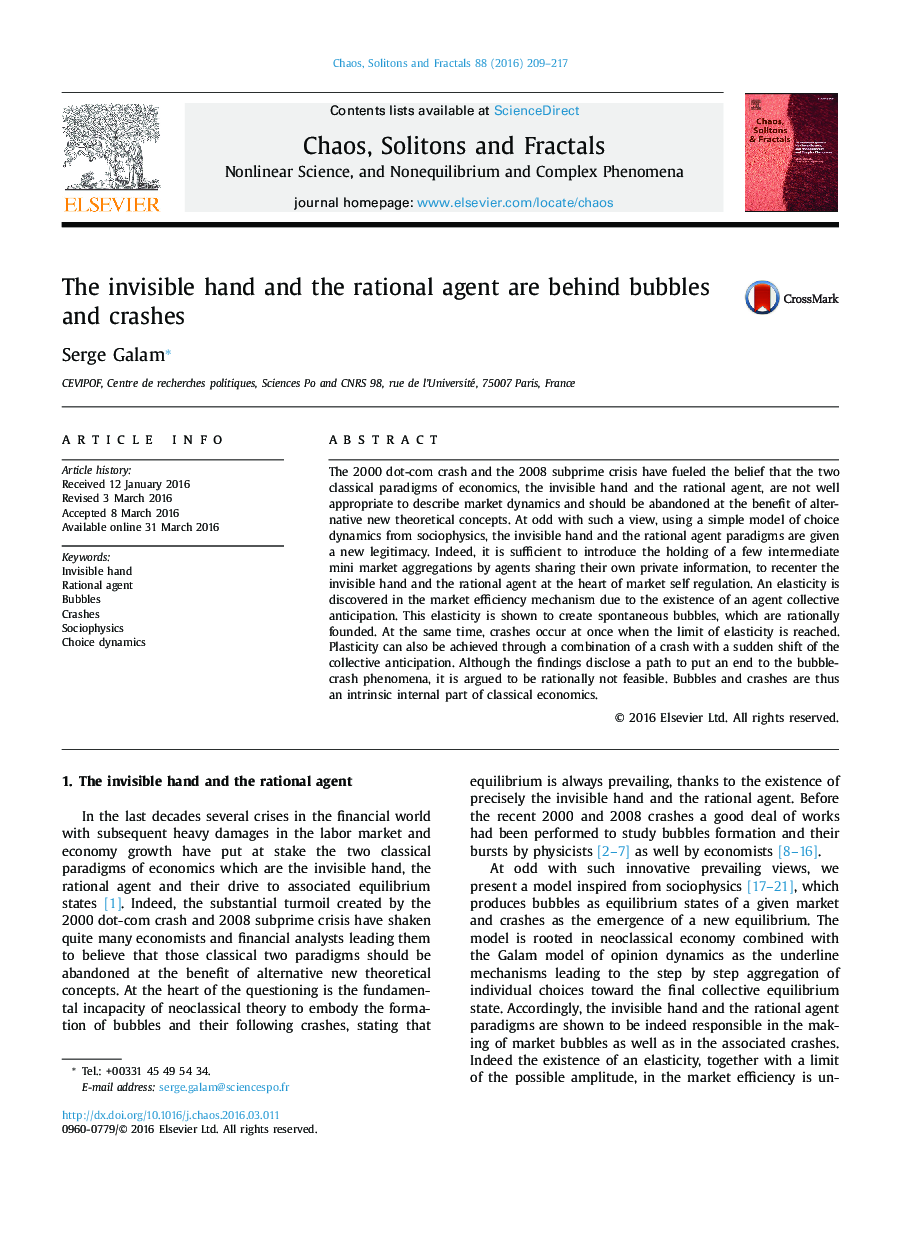| کد مقاله | کد نشریه | سال انتشار | مقاله انگلیسی | نسخه تمام متن |
|---|---|---|---|---|
| 1891155 | 1533637 | 2016 | 9 صفحه PDF | دانلود رایگان |
عنوان انگلیسی مقاله ISI
The invisible hand and the rational agent are behind bubbles and crashes
ترجمه فارسی عنوان
دست نامرئی و عامل منطقی پشت حباب و سقوط است
دانلود مقاله + سفارش ترجمه
دانلود مقاله ISI انگلیسی
رایگان برای ایرانیان
کلمات کلیدی
دست نامرئی، عامل موثر، حباب ها، سقوط، جامعه شناسی، دینامیک انتخاب
ترجمه چکیده
سقوط 2000 دات کام و بحران کمپرسور 2008 موجب اعتقاد به این نکته شده است که دو پارادایم کلاسیک اقتصاد، دست نامرئی و عامل منطقی به خوبی برای توصیف دینامیک بازار مناسب نیستند و باید از نظر نظری جدید جایگزین شوند مفاهیم. با عجیب و غریب با چنین دیدگاهی، با استفاده از یک مدل ساده از پویایی انتخابی از جامعه شناسی، دست نامرئی و پارادایم های عامل عقلانی مشروعیت جدیدی به دست می دهند. در حقیقت، کافی است که تعدادی از مؤسسات خصوصی خصوصی خود را در اختیار داشته باشیم تا بتوانند دست فرد نامرئی و عامل منطقی را در قلب خود تنظیم کنند. انعطاف پذیری در مکانیزم بازاریابی بازار به علت وجود پیش بینی جمعی عامل کشف شده است. نشان داده شده است که این کشش باعث ایجاد حباب های خودبهخودی می شود که منطقی به وجود می آیند. در همان زمان، سقوط زمانی رخ می دهد که محدودیت کشش رسیده است. پلاستیک نیز می تواند از طریق ترکیبی از یک تصادف با تغییر ناگهانی پیش بینی جمعی به دست آید. اگر چه یافته های کشف مسیری برای پایان دادن به پدیده های تصادف حباب را کشف می کنند، بحث می شود که منطقی نبوده است. حباب و سقوط در نتیجه بخش داخلی ذاتی اقتصاد کلاسیک است.
موضوعات مرتبط
مهندسی و علوم پایه
فیزیک و نجوم
فیزیک آماری و غیرخطی
چکیده انگلیسی
The 2000 dot-com crash and the 2008 subprime crisis have fueled the belief that the two classical paradigms of economics, the invisible hand and the rational agent, are not well appropriate to describe market dynamics and should be abandoned at the benefit of alternative new theoretical concepts. At odd with such a view, using a simple model of choice dynamics from sociophysics, the invisible hand and the rational agent paradigms are given a new legitimacy. Indeed, it is sufficient to introduce the holding of a few intermediate mini market aggregations by agents sharing their own private information, to recenter the invisible hand and the rational agent at the heart of market self regulation. An elasticity is discovered in the market efficiency mechanism due to the existence of an agent collective anticipation. This elasticity is shown to create spontaneous bubbles, which are rationally founded. At the same time, crashes occur at once when the limit of elasticity is reached. Plasticity can also be achieved through a combination of a crash with a sudden shift of the collective anticipation. Although the findings disclose a path to put an end to the bubble-crash phenomena, it is argued to be rationally not feasible. Bubbles and crashes are thus an intrinsic internal part of classical economics.
ناشر
Database: Elsevier - ScienceDirect (ساینس دایرکت)
Journal: Chaos, Solitons & Fractals - Volume 88, July 2016, Pages 209-217
Journal: Chaos, Solitons & Fractals - Volume 88, July 2016, Pages 209-217
نویسندگان
Serge Galam,
